In the late 17th century Antonio Stradivari was commissioned to make a series of instruments for the Medici court in Florence. Having explored how this came about in part 1, we will now examine the three ‘Medici, Tuscan’ instruments that have remained in Florence: the 1690 cello and tenor viola, and the violin from 1716. Owned by the Conservatory of Music, ‘Luigi Cherubini’ since the 1860s, these instruments are now exhibited at the Galleria dell’Accademia in Florence as part of the collections of the de’ Medici family.
Cello 1690, ‘Medici, Tuscan’
The 1690 ‘Medici’, 1697 ‘Castelbarco’ and 1701 ‘Servais’ are the only three surviving Stradivari cellos of large dimensions that have not been reduced in size. As we saw in part 1, Bartolomeo Ariberti commissioned the 1690 ‘Medici’ from Stradivari together with two violins and presented them to the Grand Prince Ferdinando de’ Medici. In September 1690 Stradivari received a letter of approval from Ariberti, who reported the enthusiasm among the Medici court for the tone qualities of the cello: ‘The other day I made a present of the two Violins and the Violoncello which you made for me to His Highness the Prince of Tuscany; and I assure you, to my great satisfaction, he has accepted them with such a pleasure that more I could not expect. The members of his orchestra… were unanimous in expressing their great appreciation, declaring the instruments quite perfect, and, above all, exclaiming with one voice that they have never heard a Violoncello with such an agreeable tone…’ [1]
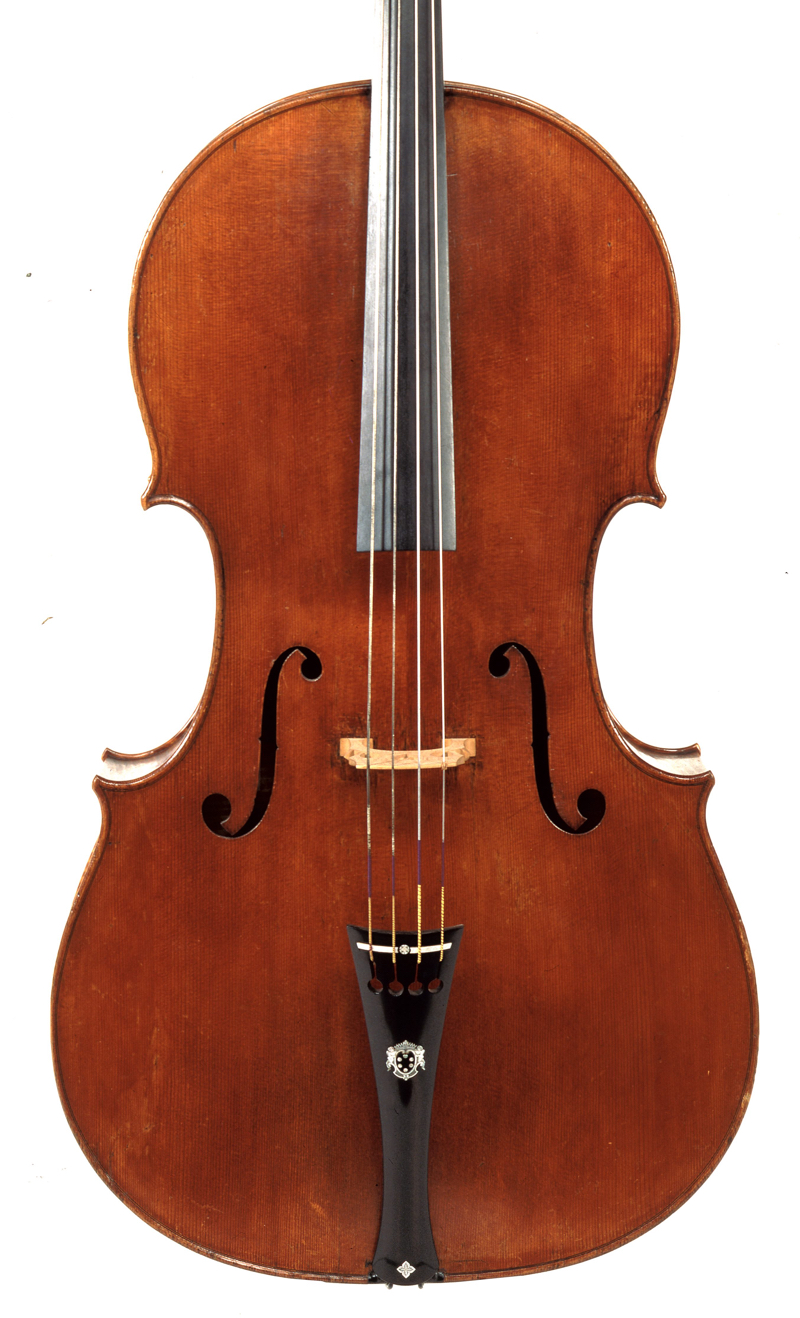
The 1690 cello. All photos: Galleria dell’ Accademia, courtesy of Italian Ministry of Cultural Heritage and Activities and Tourism
More photosThe Hills, when discussing the cellos produced by Stradivari before 1700, described the ‘Medici’ as: ‘The most perfect and representative specimen of the work of this epoch.’ [2] The two-piece back of the instrument is of maple cut on the quarter, characterised by narrow, intense and regular curl. The ribs and the scroll are of a similar maple. The inventory numbers 354 and 3766 appear on the bass rib, in the upper part of the C-bout, while the head has the number 2173 written in black ink on the bass side. The scroll retains its original black chamfer and on the pegbox it is still possible to see the mark of Stradivari’s compass.
The tailpiece has been changed, although like the original tailpiece of the tenor viola it depicts the Medici coat of arms in mother-of-pearl. A template for an inlaid cello tailpiece similar to the one of the tenor viola is exhibited at the Museo del Violino in Cremona and reproduced in the catalog of the former Museo Stradivariano. [3]
‘The other day I made a present of the two Violins and the Violoncello which you made for me to His Highness the Prince of Tuscany… he has accepted them with such a pleasure that more I could not expect’ – Ariberti
The belly is of medium-width spruce in the center, finely grained towards the edges. In the lower bouts two spruce wings were added by Stradivari to fill out the width of the cello. The varnish is of an orange-brown color over a golden ground and the cello bears an original label: ‘Antonius Stradivarius Cremonensis Faciebat Anno 1690.’
The instrument underwent a major restoration in 1877 at the suggestion of an executive committee chaired by the cellist Alfredo Piatti. [4] The work was commissioned to Luigi and Ettore Castellani and was performed by Giuseppe Scarampella, who at the time worked for the Castellani brothers. According to Ernest Doring, Scarampella replaced the neck and bass bar, and repaired some woodworm damage. [5] He recorded his work in an internal inscription close to the bass bar: ‘Restaurato da G. Scamparella Firenze – 1877.’ He did not, however, reduce the cello in size, as was mistakenly reported in the catalog of the 1937 exhibition for the Bicentennial of Stradivari’s death. [6] Scarampella’s restoration was highly praised by the executive committee and by many experts, including the Italian musicologist Giovanni De Piccolellis. [7]
The Hills reported another intervention in their 1902 book: ‘In consequence of slight ravages by worms, it was sent some years ago to Vienna for restoration (we know not to whom), when its original neck was unhesitatingly sacrificed, and the charming inlaid finger-board and tail-piece were dealt with in true Philistine manner. The pearl cupids which adorned them were, in order that they might be preserved, removed and re-inlaid on a new finger-board and tail-piece of the crudest modern make.’ [8]
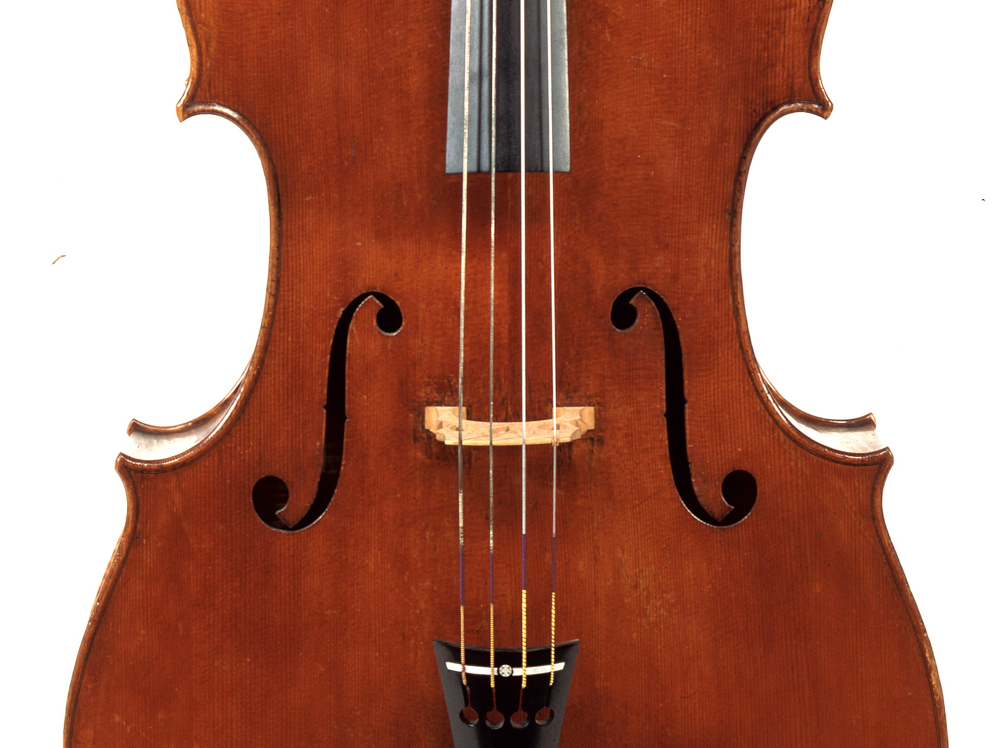
The 1690 cello was restored in 1877 by Giuseppe Scarampella. He did not, however, reduce the size of the instrument
The cello, together with the two ‘Medici’ violas, was recorded in a 1700 inventory as being part of a quintet that belonged to Ferdinando de’ Medici. Extracts from this first record and the following ones can be found in the catalog dedicated to the Medici collection. [9] After Ferdinando’s death the instrument was lent to a series of musicians and noblemen, only to return to the collection in 1765 to be restored by Lorenzo and Tommaso Carcassi. Misleadingly, William Henley recorded that the cello, along with the 1690 viola and 1716 violin, were ‘part of the collection of Bartolomeo Cristofori who was the heir of the Medici family of Florence’. [10] In fact Cristofori was employed as the custodian of the Medici collection from 1688, a role confirmed in the inventory of 1716, which he signed as ‘Bartolommeo Cristofori Custode’. [11]
From 1766–67 the cello was lent to the musician Francesco Piantanida, while in 1785 and 1786 it had returned to the Medici court. In 1790 an inventory recorded that the instrument was in Pisa [12] but it was back in Florence according to inventories produced in 1829 [13], 1846 [14], and 1861 [15]. According to Luigi Ferdinando Casamorata, when Grand Duke Ferdinand III had to flee Florence during the Napoleonic era, he left the cello in the hands of Antonio Gragnani, who had a copy made by Gaspero Piattellini, apparently to safeguard it. [16] Although a copy of the cello was indeed made by Piattellini and is now exhibited in the Galleria dell’Accademia, there is no document to confirm the truth of this story.
On joining the collection of the ‘Luigi Cherubini’ Conservatory in 1863, the cello’s value was established as £7,000, making it the most expensive instrument in the collection. [17]
Beside the books already mentioned, this instrument is illustrated in George Hart’s book, as is the tenor viola. [18] All five Medici instruments are also illustrated in Herbert K. Goodkind’s classic work on Stradivari. [19]
Tenor Viola 1690, ‘Medici, Tuscan’
The Medici tenor viola of 1690 is mentioned at the end of the letter from Bartolomeo Ariberti to Stradivari, referred to in part 1, when Ariberti asks the maker to supply two violas: ‘I have now to request you to begin at once two violas, one tenor and the other contralto, which are wanted to complete the concerto.’ [20] According to the Hills, ‘These pairs of violas by Stradivari were doubtless intended to be played in compositions of the character of the “Sonata a cinque,” by G. Legrenzi (1625–90), and the “Sonata Varie,” by J. B. Vitali (1644–92).’ [21]
The instrument has a two-piece back made from beautiful maple with narrow vivid curls that run almost horizontally. Miraculously the neck, fingerboard, tailpiece, tailnut and bridge are all original, while the monogram ‘ASC’ is stamped in the mortise of the pegbox. The bridge is of maple decorated with black ink, presenting a floral motif on one side and two mythical Atlantes on the other. The fingerboard and tailpiece are also of maple; the former has a double-row of inlaid ivory and ebony, while on the lower part a carved decoration of mother-of-pearl reproduces the Medici’s coat of arms. The tailpiece is also decorated in mother-of-pearl with a Cupid ready to shoot an arrow and a floral motif below.
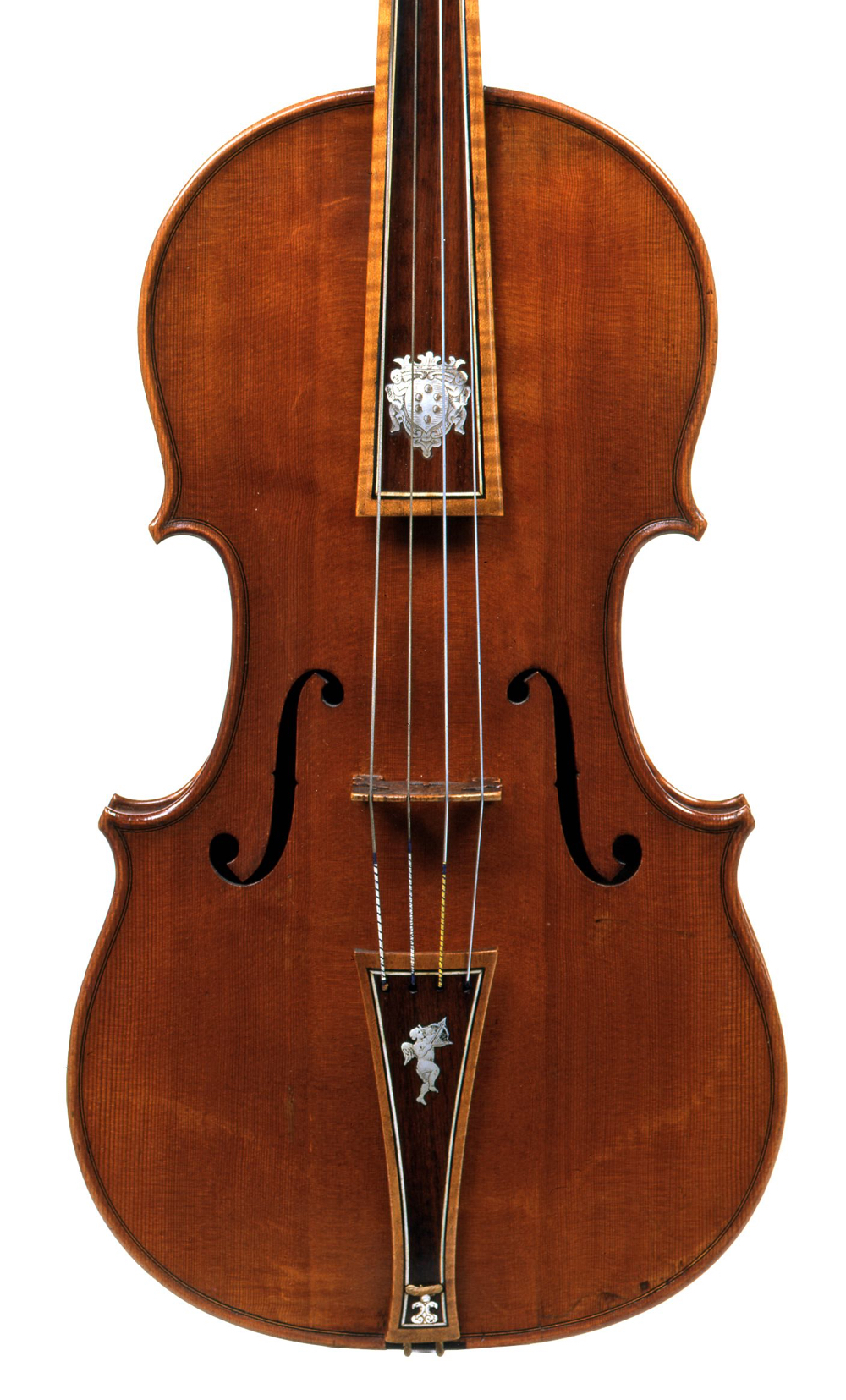
The 1690 viola is a rare tenor that has never been reduced in size. Its contralto partner went missing from the Medici inventories in the 1770s, when it appears to have left Florence
More photosThe ribs and head are made from a wood similar to that of the back. Stradivari blackened the chamfers and on the head and nut it is still possible to see the holes left by his compass. Internally, along one side of the bass bar we find handwriting that appears to be Stradivari’s: ‘Prima 20 ottobre 1690 per S. A. Da Fiorenza.’
Like the cello, the belly is of finely grained spruce in the center, widening towards the flanks and the varnish is of an orange-brown color over a golden ground. Giuseppe Scarampella performed a series of repairs on the viola to overcome woodworm damage, especially in the table, which is otherwise excellently preserved. [22] There is some evidence that Stradivari himself made adjustments or corrections to the viola at a later date, when the viola was restored on December 1869, an inscription by Stradivari was found inside: ‘corretto da me Antonio Stradivari.’ [23] The viola also bears its original label: ‘Antonius Stradivarius Cremonensis / Faciebat Anno 1690.’
Luckily this viola was never reduced in size as was common with other 17th-century tenores. Italian experts held differing views on whether to reduce it or not. De Piccolellis [24] believed that the size of the instrument made it uncomfortable to play, while the secretary of the Royal Institute of Music, Leto Bargagna, stated his admiration for it in 1911, describing it as ‘a splendid instrument, one of the most perfect works of Stradivari […] even its great size gives the instrument a kind of majesty and makes it extraordinary.’ [25]
In 1762 this viola and its contralto partner were loaned to the Marquis de Ligneville, who served the Lorraine Court in Florence and became director of music. [26] When a new inventory of the Medici collection was issued in 1776 [27], however, there was only one viola, the tenor, listed, and the following inventories from 1777 [28] and 1786 also mention only one viola. In the inventory made by the ‘Luigi Cherubini’ Conservatory in 1863 the tenor viola was given a value of only £1,000, probably because its large size made it of limited use. [29]
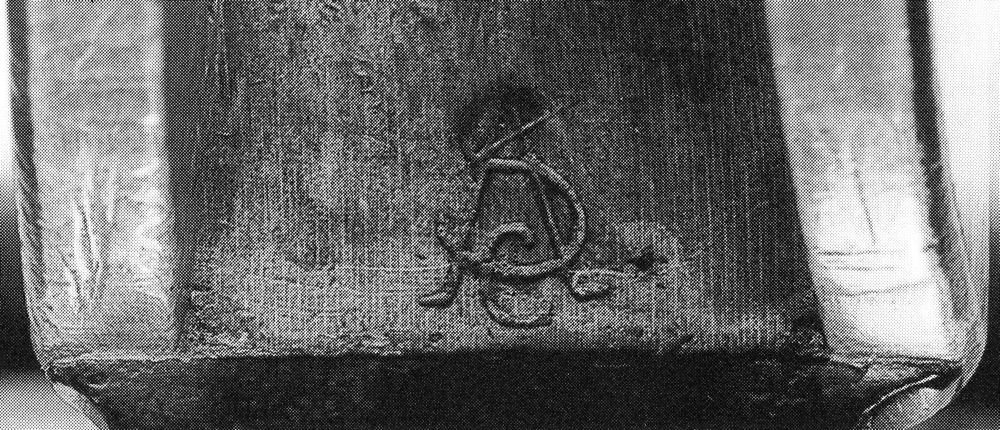
The tenor viola has the monogram ‘ASC’ stamped in the mortise of the pegbox
Stradivari’s equipment for the construction of the tenor viola has survived, comprising the mould marked with the letters ‘TV’ (tenore viola) and drawings for the f-holes, neck, scroll, fingerboard, tailpiece and bridge. This material can be seen at the Museo del Violino in Cremona and is reproduced in the catalog of the former Museo Stradivariano. [30]
Violin 1716, ‘Medici, Tuscan’
It is unclear when the violin dated 1716 reached Florence. The letter from Ariberti to Stradivari of 1690, as we have seen, hinted that new commissions from the Medici were foreseeable in the future. George Hart linked this document to the 1716 violin, writing: ‘It is therefore evident that the belief of the Marquis that Stradivari would receive further orders from the Grand Duke was realised.’ [31] Charles Beare suggested that ‘…it could have been made by Stradivari as a replacement for one of the violins of the 1690 Quintet, as at the time it was not considered satisfactory to repair damaged instruments.’ [32] It is also possible that the violin was bought after the death of the Cremonese master by a member of the House of Habsburg-Lorraine.
The claim that this violin was an addition to the original group made for the Medici court in 1690 is controversial because it is not referenced in the surviving documents of the time
The claim that this violin was an addition to the original group made for the Medici court in 1690 is controversial because it is not referenced in the surviving documents of the time. In fact it is first mentioned in a record from December 1819, when the Medici no longer ruled Tuscany. [33]
In 1888 the Director of the Musical Institute of Florence, Filippo Torrigiani, appointed a committee of experts chaired by De Piccolellis to examine the violin. [34] The committee declared it beyond doubt an original Stradivari. In the early 20th century the Hill brothers and Leandro Bisiach [35] both confirmed the instrument as original, as did Fridolin Hamma and Simone Ferdinando Sacconi during the violin’s appearance at the 1937 exhibition in Cremona. [36] Yet some have not only rejected that the violin belonged to the Medici court but also excluded it from Stradivari’s opus, mainly because of its dark red-brown varnish. Among them were Gaetano Sgarabotto [37] and Leto Bargagna. The latter attributed the violin to Jean-Baptiste Vuillaume. [38]
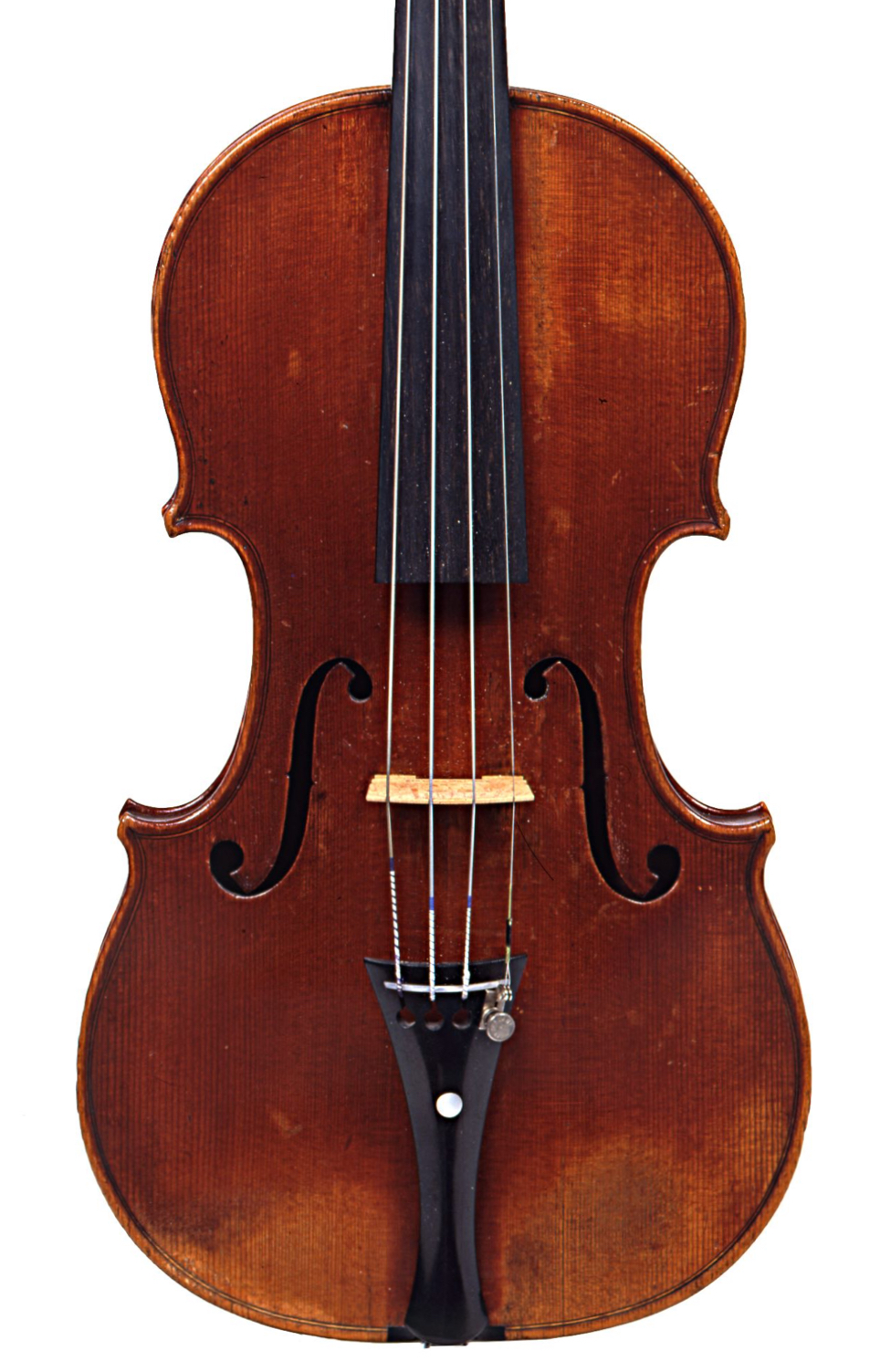
Some have suggested that the 1716 ‘Medici’ violin could have been commissioned as a replacement for one of the 1690 violins
More photosOne reason for questioning the authenticity of the violin was its remarkable state of preservation. Despite this, the Hills never seemed to have doubted that it was a genuine Stradivari and drew a parallel between the ‘Messiah’ (‘Salabue’) and the ‘Medici’, writing: ‘Other specimen exist sufficiently well preserved to indicate clearly the maker’s intentions, and the most appropriate or present comparison is the Medici violin, preserved with the Tuscan tenor and violoncello at the Musical Institute in Florence. It is of the same year and is in remarkable preservation, though not perfect; yet it differs in form, dimensions, model, sound-holes, edges, and varnish. To the casual observer it would be taken for the Salabue’s brother, as it presents a close resemblance, whether as regards the back, which is in two pieces, the wood, which is similarly figured, or the varnish, which, though of thicker texture and somewhat deeper colour, has the same bright, unworn surface.’ [39]
The violin’s two-piece back is of maple with strong tiger-striped curls. The ribs and the scroll are of a similar wood. The head is particularly beautiful and well balanced, its design highlighted by black chamfers, with the letter ‘G’ handwritten at the base of the pegbox. Henley claimed that the scroll was not original, but was apparently mistaken. [40] In the inventory from 1840 Piattellini declared he had restored only a piece of mother-of-pearl in a tuning peg. [41]
‘To the casual observer [the 1716 Medici] would be taken for the Salabue’s brother, as it presents a close resemblance’ – The Hills
The belly is of spruce finely grained in the center, opening slightly towards the edges. The treble side is more finely grained than the bass. The varnish is of a red-brown color, completely original and still quite abundant, although it has a small craquelure especially on the ribs in the corners. The violin bears its original label: ‘Antonius Stradivarius Cremonensis Faciebat Anno 1716.’
The violin remained part of the court of the Grand Duke of Tuscany after the death in 1737 of Gian Gastone de’ Medici, the last Medicean Grand Duke of Tuscany, as is confirmed by the inventories of 1829 [42] and 1846 [43], and it was handed down to the Florentine Royal Music Institute in 1861. In the inventory of that year, the value of the violin was established at £6,000. [44]
Together these three Stradivari instruments were displayed in Cremona at the 1937 exhibition to mark the Bicentennial of Stradivari’s death and again in the 1987 exhibition, and they have appeared individually in various other exhibitions. They are normally viewable as part of the permanent collection of the Galleria dell’Accademia in Florence.
Alessandra Barabaschi is an Italian art historian and has authored several books. She held a lecture about the Stradivari Medici Quintet at the Library of Congress, Washington, D.C., in December 2018.
In part 3 we examine the remaining two 1690 instruments, now housed in Rome and Washington.
Notes
[1] Arisi, Don Desiderio, manuscript in the Government Library of Cremona (A.A.2.21. cc. 37v and 38r), also in: Gai, Vinicio, Gli strumenti musicali della Corte Medicea e il Museo del Conservatorio ‘Luigi Cherubini’ di Firenze, Licosa, Florence, 1969, p. 49. (Translation from Hart, George, The Violin: Its Famous Makers and Their Imitators, First edition 1875, Reprint Dulau & Co., London, 1909, p. 193.)
[2] Hill, William Henry; Hill, Arthur Frederick; Hill, Alfred Ebsworth, Antonio Stradivari. His Life and Work (1644–1737), William E. Hill & Sons, London, 1902, reprint 1963, Dover, New York, p. 116.
[3] Mosconi, Andrea; Torresani, Carlo, Il Museo Stradivariano di Cremona, Cremonabooks, Cremona, 2001, p. 58.
[4] Gai, Vinicio, Op. cit., pp. 53-58.
[5] Doring, Ernest N., Violins at Florence, Violins & Violinists, Vol. 7, No. 9, October 1946, p. 381.
[6] Gregori, Giampaolo, L’Esposizione di liuteria antica a Cremona nel 1937, Editrice Turris, Cremona, 1987, p. 66.
[7] De Piccolellis, Giovanni, Esame della Viola e del Violoncello Mediceo, Atti dell’Accademia del R. Istituto musicale di Firenze. Dell’autenticità e del pregio di taluni strumenti ad arco, Galletti e Cocci, Florence, 1889, p. 32.
[8] Hill, W. H.; Hill, A. F.; Hill, A. E., Op. cit., p. 236.
[9] Falletti, Franca; Meucci, Renato; Rossi Rognoni, Gabriele, La musica e i suoi strumenti: La Collezione Granducale del Conservatorio Cherubini, Giunti, Florence, 2001, p. 147.
[10] Henley, William, Antonio Stradivari, master luthier, Amati Publishing Ltd, Brighton, Sussex, 1961, p. 92.
[11] A.S.F. GM 1306bis, Inventario di strumenti, 23 September 1716, c. 4v.
[12] A.S.F. IRC 5004, Inventario di Pisa, 22 January 1790, p. 69.
[13] A.S.F. IRC 4707, Inventario di Palazzo Pitti, vol. I, 30 June 1829, p. 197.
[14] A.S.F. IRC 4715, Inventario di Palazzo Pitti, 1846, c. 167r.
[15] A.S.G.P. MPP, Inventario dei mobili di Palazzo Pitti, vol. I, 2 April 1861, p. 222.
[16] Letter written by Luigi Ferdinando Casamorata, President of the Royal Institute of Music, to the Italian Finance Minister, 7 January 1869, reproduced in: Gai, Vinicio, Op. cit., p. 40.
[17] Catalog Antichi strumenti. Collezioni dei Medici e dei Lorena, Palazzo Pitti, Florence, February-December 1980, Giunti-Barbèra, Florence, p. 58.
[18] Hart, George, Op. cit., plate 21 facing p. 368.
[19] Goodkind, Herbert K., Violin Iconography of Antonio Stradivari, Larchmont, New York, 1972, cello 1690 p. 223, tenor viola 1690 p. 225, contralto viola 1690 p. 224, violin 1690 p. 222, violin 1716 p. 468.
[20] Arisi, Don D., Op. cit., also in: Gai, V., Op. cit., p. 49. (Translation from Hart, George Op. cit.)
[21] Hill, W. H.; Hill, A. F.; Hill, A. E., Op. cit., p. 99.
[22] Doring, Ernest N., How Many Strads? – Supplemental, Violins & Violinists, Vol. 7, No. 1, October-November 1945, p. 19.
[23] De Piccolellis, Giovanni, Liutai antichi e moderni, Successori le Monnier, Florence, 1885, p. 79.
[24] De Piccolellis, G., Esame della Viola e del Violoncello Mediceo, Op. cit., p. 30.
[25] Bargagna, Leto, Gli strumenti musicali raccolti nel Museo del R. Istituto L. Cherubini a Firenze, Piccoli, Florence, 1911, p. 17.
[26] A.S.F. IRC 3391, Giornale della Guardaroba Generale, c. 174r, 16 October 1762.
[27] A.S.F. IRC 3444, Affari diversi, n. 904, lettera 8, c. 1v, 5 October 1776.
[28] A.S.F. IRC 3444, Affari diversi, n. 836, c. 3, 17 March 1777.
[29] Catalog Antichi strumenti. Collezioni dei Medici e dei Lorena, Op. cit., p. 45.
[30] Mosconi, A.; Torresani, C., Il Museo Stradivariano di Cremona, Op. cit., p. 57.
[31] Hart, G., Op. cit., p. 195.
[32] Beare, C., Capolavori di Antonio Stradivari, Arnoldo Mondadori Editore, Milan, 1987., p. 88.
[33] A.S.F. IRC 4699, Inventario a capi di Palazzo Pitti, 18 December 1819, as mentioned in: Falletti, F.; Meucci, R.; Rossi Rognoni, G., Op. cit., p. 137.
[34] De Piccolellis, G., Op. cit., pp. 26-29.
[35] Alfred Hill, 1 April 1930; Leandro Bisiach, 11 May 1931; reproduced in: Gai, V., Op. cit., pp. 60 & 61
[36] Fridolin Hamma and Simone Sacconi, 15 May 1937, reproduced in: Gai, V., Op. cit., p. 61.
[37] Gai, V., Op. cit., p. 60.
[38] Bargagna, L., Op. cit., p. 16.
[39] Hill, W. H.; Hill, A. F.; Hill, A. E., Op. cit., p. 65.
[40] Henley, W., Op. cit., p. 62.
[41] A.S.F IRC 4057, Giustificazione della Guardaroba, August 1840, n. 374.
[42] A.S.F. IRC 4707, Inventario di Palazzo Pitti, 30 June 1829, p. 197.
[43] A.S.F. IRC 4715, Inventario di Palazzo Pitti, 1846, c. 167r.
[44] A.S.F. MPP, Inventario dei mobili di Palazzo Pitti, vol. I, 2 April 1861, p. 221.